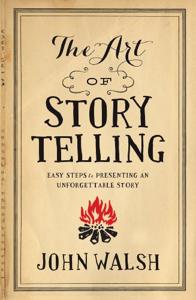
Want to learn the ideas in The Art of Storytelling better than ever? Read the world’s #1 book summary of The Art of Storytelling by John Walsh here.
Read a brief 1-Page Summary or watch video summaries curated by our expert team. Note: this book guide is not affiliated with or endorsed by the publisher or author, and we always encourage you to purchase and read the full book.
Video Summaries of The Art of Storytelling
We’ve scoured the Internet for the very best videos on The Art of Storytelling, from high-quality videos summaries to interviews or commentary by John Walsh.
1-Page Summary of The Art of Storytelling
Overview
If you’ve ever watched a TV show about lawyers and trials, like Law & Order or Boston Legal, you’ll know that the law is full of plotlines. But have you ever paid attention to how they’re constructed?
Successful TV series and court cases have a lot in common. They are both about winning over an audience, whether it’s the jury or TV viewers. Here we will learn from a successful attorney who is also a writer for television shows. We’ll get tips on how to tell stories to laypeople and law people alike.
In addition, you’ll learn what the rhetoric triangle is and how to use it. You’ll also learn why just telling a story with emotion isn’t enough and how to combine logic in three steps to make a winning argument.
Big Idea #1: Storytelling, though not taught in law school, is one of the most important skills a lawyer can have.
To be a good lawyer, you need to convince the judge or jury of your point of view. The best way to do this is by telling them a compelling story that will make them see things your way.
However, a lawyer needs to tell the story in a way that makes it easy for the jury to understand.
Let’s start with the basics. When a lawyer takes on a case, it is her responsibility to study every piece of evidence she can get her hands on and analyze them thoroughly in order to understand the story behind them. These pieces are the building blocks of that narrative.
The details of the evidence supply the characters, motivations, actions and conflict that form the plot.
Furthermore, having a solid understanding of storytelling can help you in other areas. For example, it will help you with delivering your ideas in court and acquiring clients. It can also aid with convincing your boss to give you a promotion.
Despite the benefits of storytelling, law schools don’t teach students how to tell stories. There isn’t even one course on story telling in today’s curriculum.
Instead of learning how to write and research, law students learn about the technical aspects of writing. They get no instruction on creative writing or storytelling. It’s up to lawyers themselves to figure out how to tell a good story in a compelling way.
The next section will explore the history of story telling, starting with ancient times.
Big Idea #2: By incorporating a few techniques from the ancient Greeks, any lawyer can be a great storyteller.
The roots of modern storytelling go all the way back to ancient Greece, where Aristotle was the first person to identify three key elements that make up a good story: credibility, logic and emotion.
There are three elements to every argument: logic, emotion and facts. If you’re a lawyer, your arguments will probably have a strong emotional component; however, if you want the audience to be convinced by your argument, then it’s important that they also understand the logic behind it.
In the example, you can present your case with logic and emotion. However, to make it credible, you need sources that validate what you’re saying.
The legal profession is all about credibility. That’s why lawyers have to pass a test before they can practice. Clients and juries need to feel assured that the lawyer understands the law fully, so they can trust him or her in court.
The credibility of witnesses in court cases is critical to winning the case. It’s your job as a lawyer to make sure that your witnesses are credible and that those for the opposing side aren’t. To do this, you should have an organized office space with no clutter or disorganization. Clients like attorneys who look professional and keep their offices tidy because they feel more confident in them when it comes time to take action on their legal matters.





